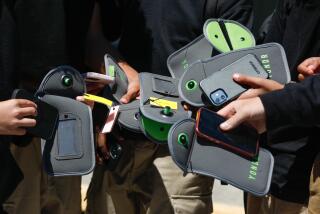Will students really get off cellphones? California’s Phone-Free Schools Act, explained

- Share via
California legislators have passed a milestone law requiring schools to devise plans to restrict or ban student cellphone use on campus, aiming to squelch classroom distractions and harmful social media use.
Gov. Gavin Newsom is expected to sign the bill, which would mandate 1,000 school districts, charter schools and county offices of education across the state to draft their policies by July 1, 2026.
“It is not overly prescriptive,” said Assemblyman Josh Hoover (R-Folsom), who introduced the bill. “We obviously require districts to take action by passing a policy to limit smartphone use, but we don’t tell them exactly how they have to do that.”
Many schools districts have already created their own policies to restrict phones in and outside of class, with varying success and ongoing adaptation. In the battle to determine what works and what doesn’t, the law holds promise but could also lead to a hazy landscape of policies at districts throughout the state. And for schools that have adopted bans, some crafty students find ways around them.
Here are the details of California’s Phone-Free Schools Act:
What does the bill mandate?
The bill builds off of Assemblyman Al Muratsuchi’s (D-Rolling Hills Estates) 2019 law that allowed school districts to adopt a policy to limit or prohibit smartphone use in schools. Under the new measure, restrictions will be required.
Schools must consult students, parents and educators to come up with their policies and update it every five years. The goal is to support “pupil learning and well-being” in line with “evidence-based use of smartphone practices,” the measure says.
The policy authorizes schools to use tools such as lockers or locking phone pouches to enforce the policy when students are on campus or under the supervision of a district employee, such as on a field trip.
The bill also clarifies that schools may not access, collect or monitor a student’s online activity. The measure does not set out the rule, but mandates school districts to come up with their own restrictions or bans.
What about emergencies during the school day?
Students will be still allowed to access phones during an emergency. The legislation, however, does not say that the phone must be a student’s own device — and it’s up to school districts to decide what constitutes an emergency.
L.A. Unified Supt. Alberto Carvalho said the district is working out what scenarios will be defined as emergencies and how they can provide students with “reasonable access” to phones in those circumstances.
Sen. Ben Allen (D-Santa Monica), a co-author of the bill, said that policies may be different for different emergencies — such as an active shooter versus an earthquake. Regardless, he understands the desire of students and parents to connect in the aftermath of an emergency.
Are there other exceptions?
The law bars schools from prohibiting smartphones when a licensed physician or surgeon decides that a phone is vital for the health or well-being of a student. Phones may also be allowed if needed for a student’s individualized education program.
Students who are English learners, for example, may rely on their devices to learn, just as students with diabetes may require a phone to monitor their glucose levels, Carvalho said.
The law also gives teachers and administrators permission to override their school district’s policy, effectively creating their own.
How will schools pay for phone “lockers” or other enforcement tools?
A big concern with the ban is equity, especially when some schools may not be able to pay for tools to help them enforce it.
“For a school as small as ours it was going be about $20,000,” Girls Academic Leadership Academy Principal Liz Ackerman-Hicks said of their decision not to implement popular Yondr pouches, which use magnets to lock and unlock the pouches that contain phones. “That could pay for a lot of after-school tutoring and after-school activities.”
With LAUSD’s new policy set to take effect in January, L.A. school board member Nick Melvoin said the district is considering reimbursing schools that have taken on that cost and paying for implementation moving forward.
Because the law is a state mandate, schools can apply for state reimburserment or use their existing grants dedicated to pay for services that are required by law.
What do educators think of the law?
Though teachers have maintained that phone bans have been beneficial to their classrooms, they emphasize that it cannot be an unsupported mandate. It is particularly important, they say, that the burden of enforcement does not fall on them and take away instructional time.
David Goldberg, president of the California Teacher Assn., said the union supports restricting the use of smartphones on campus but added that districts must consult students and their families as they make their policies.
“Educators care deeply about the well-being of our students and their families and should be included in decisions about changes to our school communities,” Goldberg said in a statement to The Times.
Educators such as KJ STEM Academy teacher Ajaya Ram added that if parents buy into the policy, they can also take steps to limit student phone usage, such as setting parental controls that restrict access to certain apps during the school day.
The California Assn. of School Boards, however, opposes the bill. Spokesperson Troy Flint said the measure takes authority away from school district leaders who may do their own research and decide that limiting or banning phones would not benefit their students.
The group intends to ask Newsom to veto the bill, but if approved, Flint said they will support school districts and monitor the law’s impact and possible unintended consequences.
What are students saying?
Though students understand the reasoning behind stricter policies — agreeing that phones are a distraction — many wonder whether an outright ban is the solution.
If students don’t have a say in the new policies, schools may have trouble with compliance, said students who attended California Supt. of Public Instruction Tony Thurmond’s Task Force to Close the Digital Divide meeting Tuesday.
“For my peers, it will say that they definitely struggled a lot because the Yondr pouches came out of nowhere and we didn’t really understand what was happening,” said an eighth-grader at Bayside Academy, a K-8 school in San Mateo. “Their focus then became trying to figure out ways to go around the policy and figure out how not to use the pouches.”
If students saw the policy as a consensus, rather than a punishment, she said many more would have been onboard. She also recommended that schools offer positive behavior incentives, like pouch-free days, to reward student compliance.
The high schoolers on the panel said elementary, middle and high school provide “radically different” environments that have to be considered when creating phone policies.
“The state of California has 2 million high schoolers,” said Mia George, a senior at Folsom High School. “If they’re going to be telling those 2 million kids what to do from ninth to 12th grade, when are those students going to be able to make that decision themselves?”
Trinidad Menchu, a recent graduate of Dorsey Senior High, said her phone helps her concentrate during independent work because it allows her to listen to music. She added that her teachers don’t typically lead by example, scrolling on their own phones during that time.
Sadie and Piper Hoodenpyle, students at Girls Academic Leadership Academy, added that phones can be beneficial for taking pictures of lecture slides, filming telenovelas in Spanish and checking their weightlifting form. They have also been a lifeline in cases of emergency, they added, so they can ensure that their sibling is OK and keep their parents up to date.
The Bayside eighth-grader recommended that schools put Yondr magnets in each classroom so that students can unlock their phones in case of an emergency.
More to Read
Sign up for Essential California
The most important California stories and recommendations in your inbox every morning.
You may occasionally receive promotional content from the Los Angeles Times.











